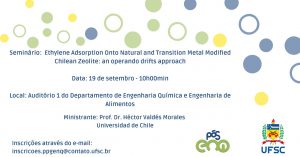Research Seminar – Ethylene adsorption onto natural and transition metal modified Chilean zeolite: an Operando DRIFTS approach

O PósENQ convida toda a comunidade acadêmica para participar do Semário “Ethylene adsorption onto natural and transition metal modified Chilean zeolite: an Operando DRIFTS approach“. O seminário será ministrado pelo Prof. Dr. Héctor Valdés (Clean Technologies Laboratory, Engineering Faculty, Universidad Católica de la Santísima Concepción, Alonso de Ribera 2850, Concepción, Chile) no dia 19 de setembro, às 10h00min, no auditório I do EQA. As inscrições serão realizadas através do email inscricoes.ppgenq@contato.ufsc.br.
Resumo:
Ethylene is a plant growth regulator that induces accelerated softening and ripening of fruits during transport and storage. Among the most applied methods for ethylene control, adsorption appears as a cheap and efficient technique. In this work, the effect of the incorporation of transition metals into natural Chilean zeolite on ethylene adsorption is investigated. Natural zeolite mainly composed of clinoptilotite and mordenite is modified using copper and zinc nitrate solutions and calcined under oxygen flow at 623 K, generating different transition metal modified zeolites. Parent and modified zeolites were characterised by X-ray diffraction, X-ray fluorescence spectroscopy and nitrogen adsorption. Zeolite surface modifications were assessed by diffuse reflectance infrared Fourier transform spectroscopy (DRIFTS). Experimental results reveal the incorporation of Cu2+ and Zn2+ as new compensating cations into the zeolite framework. Ethylene adsorption isotherms show an enhancement on the adsorption capacity of Cu-exchanged zeolite. This result is not only associated to the higher micropore surface area of this sample, but also to the higher affinity of ethylene molecules to copper cations incorporated on this zeolite. DRIFTS operando experiments of ethylene adsorption in the absence and in the presence of moisture reveal a competitive mechanism of water and ethylene molecules toward hydroxyl sites. Si-OH-Al and Si-OH sites are rapidly occupied with water, reducing the adsorption of ethylene.





















